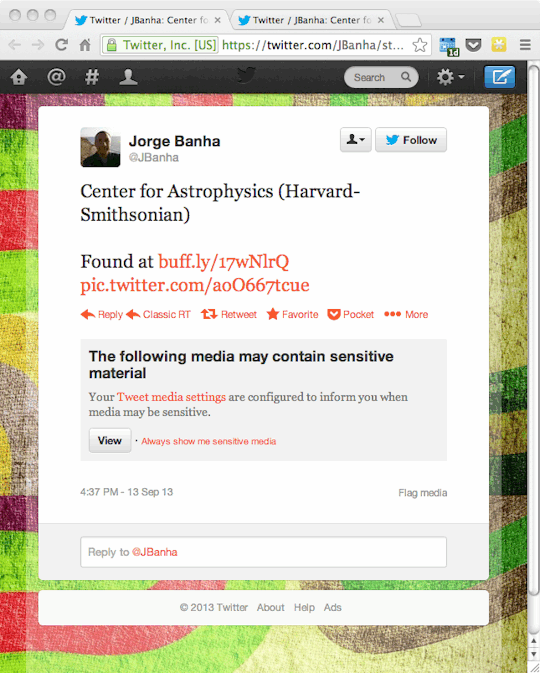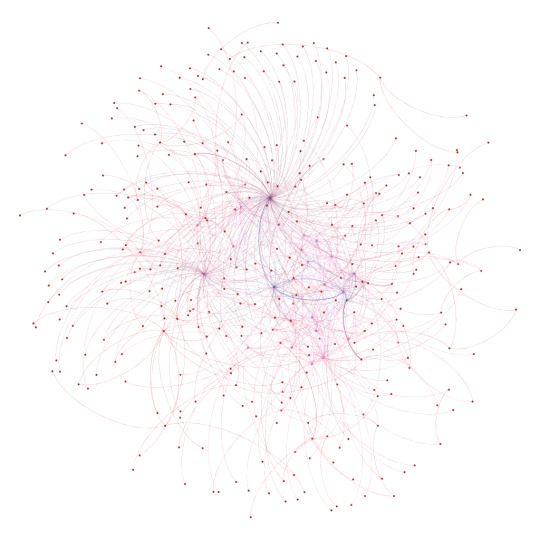Take a little pinch of Astronomy, add in some Astrophysics and a dash of Semantic-Web Technologies. You end up with Doug's rambling pie.
Don't wanna be here? Send us removal request.
Photo

Apparently Twitter thinks that black holes are only dangerous to the under 18s.
0 notes
Photo

A quick look at the way twitters at the summer AAS meeting in Boston (AAS 218) referred to each other. The change in color (red to purple to blue) indicates to some degree how important[^1] each Tweeter was with regard to being mentioned by other Tweeters, but it was mainly chosen for aesthetic reasons[^2]. There's a few other visualizations of this data available, if you're interested.
[^1] If you really want to know, I used the "Eigenvector Centrality" measure from Gephi to color the nodes and edges.
[^2] For instance, it might be nice to view the names (or at least id's) of the Tweeters.
5 notes
·
View notes
Text
In praise of engineers
About this time last week, a bunch of engineers (and scientists) were beavering away over at the Chandra Operations center trying to understand why the satellite had gone into "safe mode"1 and whether we could recover. By now, Chandra has resumed it's scientific mission - to look at lots of cool things in the Universe2 - and we now know what happened and how to stop it happening again. So, I just wanted to say a big thank you to the engineers; I hope you're able to enjoy this week end!
Doug
The on-board computers on Chandra can determine when it has entered into an anomalous state - such as "oh, I'm bored of this, I want to look at Sco X-1" - and over-ride the programmed schedule, shutting things down to reduce the risk of injury. Sco X-1 (aka Scorpius X-1) is a rather bright source of X-rays and looking at it would not be good for the health and welfare of the instruments on board Chandra; it's the telescope's version of being told not to look directly at the sun. ↩︎
This is a bad pun, since things have to be pretty hot to emit radiation at the wavelengths that Chandra can see. ↩︎
0 notes
Text
Finding Messier objects in DBPedia via Spark
So, I was in the middle of planning a post discussing various ways of searching for Astronomical objects - in particular [M31](http://en.wikipedia.org/wiki/Andromeda_Galaxy) - in [DBPedia](http://dbpedia.org/), when along comes an announcement of the [Spark javascript library](http://km.aifb.kit.edu/sites/spark/). So, instead of working on the post, I created a simple web page to test it out, and it works. Lo and behold, I give you a [dynamically-generated list of Messier Objects](http://hea-www.harvard.edu/~dburke/playground/messier-spark.html). The page took about 20 minutes to create, and most of that was faffing around with the CSS and deciding exactly what properties I wanted to show. This is cool. Not quite as cool as [going for a ride into space](http://blogs.discovermagazine.com/badastronomy/2011/03/04/ride-an-srb-video-into-space/), but still, not bad at all. More to come later...
11 notes
·
View notes
Text
The future moves fast around here
Take that, cool picture of the launch of Johannes Kepler to the ISS. You've been out-cooled by the launch of Discovery.
Credit: Quest for Stars / Challenger Center and MSNBC
This is a frame grab from a video shot by a GoPro Hero Motorsport on a helium balloon launched to image the shuttle Discovery as it transited the stratosphere. The fogging is due to the fact that the balloon is coming through the troposphere when this picture was taken at 5:05 ET.
0 notes
Link
This morning I got to see a picture, taken from the ISS, of the launch of ESA's ATV, Johannes Kepler, sent to keep it re-stocked.
I found out about this because the Astronaut who took the picture - Paolo Nespoli - can upload pictures from space onto flickr and then have people tweet about it.
Whilst there's many things wrong with the world, this is just cool.
0 notes
Text
Astronomy and the Semantic Web
## Astronomy, Semantics and Linked Data So why, you might ask, am I - an Astrophysicist - interested in semantics, specifically [the semantic web](http://www.w3.org/standards/semanticweb/) and [linked data](http://linkeddata.org/). Am I not just buying into the [AI hype of the 80s](http://c2.com/cgi/wiki?AiWinter), repurposed for the 21st century? It's quite possible, but if we ignore some of the more extreme claims made about this approach, there is already plenty that we can do to help us in our work, as shown by the [Virtual Solar and Terrestial Observatory](http://dx.doi.org/10.1016/j.cageo.2007.12.019). I encourage you to read Jim Hendler's Nature Network blog article [What is the Semantic Web really all about?](http://blogs.nature.com/jhendler/2009/06/16/what-is-the-semantic-web-really-all-about), for an overview of this area. ## Literature An obvious place to start is the literature since we are fortunate to have two major portals for accessing this data online - pre-prints at [arXiv.org](http://arxiv.org/archive/astro-ph/) and published material at [ADS](http://adswww.harvard.edu/) - which are already inter-linked and provide a wealth of data that we can take advantage of. There are a number of interesting developments in this space - some more "semanticy" than others - including (but not limited to) [ADS labs](http://labs.adsabs.harvard.edu/), [Mendeley](http://www.mendeley.com/), [Zotero](http://www.zotero.org/), [arxivsorter](http://arxivsorter.org/) - and then there's work that I am involved in, funded by the [US VAO project](http://www.usvao.org/), to combine literature and data into a bowl of semantic goodness at the ADS. I'll leave further discussions on this to a later post, since what I really wanted to talk about was Outreach. ## Astronomy Outreach I have been convinced for several years now that Semantic technologies can, and *should*, be used to improve access to Education and Outreach efforts in Astronomy and Astrophysics. The application of simple classification schemes[^simple] such as the [Ontology of Astronomical Object Types](http://www.ivoa.net/Documents/Notes/AstrObjectOntology/) to data collections including [Astronomy Picture Of the Day](http://apod.nasa.gov/), [astronomical images on flickr](http://www.flickr.com/search/groups/?q=astronomy), images from the [Las Cumbres Observatory Global Telescope Network](http://lcogt.net/) and the press releases from observatories like [Chandra](http://chandra.harvard.edu/press/press_release.html) can, I believe, enhance the reader's understanding and enjoyment of the material, as well as providing more avenues for enquiry and understanding. In my spare time I've [explored several avenues](https://dspace.gla.ac.uk/handle/1905/809) - such as [semantic tagging with Astro MOAT](http://hea-www.harvard.edu/~dburke/vo/astromoat/) - and have grand visions, but have yet to get anything really working. ## A case study One of the first examples in this area (that I know of), has been provided by [Stuart Lowe](http://lcogt.net/en/blog/slowe), who combined observational data from the Las Cumbres Observatory telescope network with the [education data provided by the UK Government](http://education.data.gov.uk/doc/school) to [look at where the users of the telescopes are](http://lcogt.net/en/blog/slowe/linking-data), at least for schools in England and Wales. For this particular example I'm sure Stuart would have found it easier just to be able to access simple tabular data sets[^rdf] rather than learn a whole new technology stack[^semwebstack]. In fact, I think this is often true of many "simple" semantic applications; there's always a simpler approach *if* you already understand the format and layout of the data you are given. The reason for using these semantic technologies is when you do not know, ahead of time, exactly what you want or how the data is stored[^freelunch]. In this regard I see Semantics as being synonymous with "Data Integration and Exploration", but I don't really see this particular Three-Letter Acronym becoming very popular. I have been noodling around trying to use the vocabularies we are writing for the ADS project - in particular those dealing with observational data - to try and model the LCOGTN data such as [this observation](http://lcogt.net/en/observations/coj/2m0a/54003) of [30 Doradus](http://en.wikipedia.org/wiki/Tarantula_Nebula) by [Shoeburyness High School](http://education.data.gov.uk/doc/school/115210). This work has fallen by the way side, so I'm hoping to write up my steps following the approach of [Keith ALexander's LOD by hand](http://lodbyhand.tumblr.com/), as a way of re-starting the work. If I do, you'll be the first to know :-) ------------------------ [^simple]: Here *simple* refers to the fact that the scheme does not rely on the more expressive parts of Semantic technologies, such as application of rules or logical inference capabilities; I know that creation of these schemes is not an easy job. [^rdf]: There are arguments that you do not *need* data in [RDF](http://www.w3.org/RDF/) - which we can assume for the purpose of this post to be magical pixie dust that makes everything just *work* - to take advantage of semantic technologies (e.g. the [blog](http://www.openlinksw.com/blog/~kidehen/index.vspx) and [twitter feed](https://twitter.com/kidehen) of Kingsley Idehen), but at present most of the supporting infrastructure and documentation assume the presence of RDF. [^semwebstack]: This includes, but is not limited to RDF, [SPARQL](http://www.w3.org/TR/rdf-sparql-query/) and the [linked data cloud](http://linkeddata.org/). [^freelunch]: This does not come for free, unfortunately, since someone, somewhere, has to do all the curation and provide access to the data.
3 notes
·
View notes